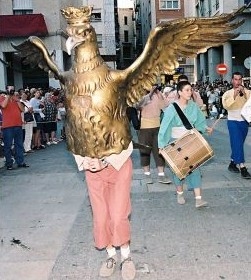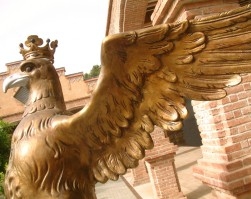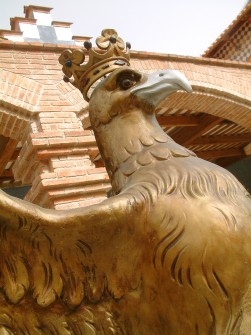
In Tortosa, we have the following beasts: the Cucafera, who has become a fully-fledged member of the community, the eagle, the ox and the horses.
The Priest of Vallfogona has the following to say about these beasts:

The designs are approximate, taken from similar beasts found in other towns around Catalunya, as collected by J. Amades in his compilation of Catalan customs. However, Amades did not record the existence of these zoological species in Tortosa. We would imagine that they would not be very different from other beasts that he recorded, although it would be extremely interesting to discover what variations they may have had in our city.
According to the French archaeologist, C. Cahier, Amades states that the eagle belongs to the realm of “mystical zoology”: animals chosen to represent virtues. The eagle stands for justice. However, Josep Pijoan believes that our eagle may symbolize the Crown of Aragon, as it is Ghibelline in origin and it was the emblem of this faction. Only cities can have the eagle. The fact that it appears wearing a crown seems to give strength Pijoan’s position because it gives the impression of being a heraldic eagle. Being our city’s eagle, it seems right to design it in line with the second theory: the heraldic eagle of the City de Tortosa, belonging to the Crown of Aragon, so closely linked to the Count and King as was the case.
Unfortunately, there is no other information available about the Eagle of Tortosa. In terms of its size, its measurements are as follows:

2.2 m wide (wingspan)
1.70 m long (from the end of the tail to the crown on top of its head)
The first record of the eagle’s existence dates back to the Middle Ages. However, there are documents which reveal that it was involved in the procession until 1556, with a carrier and three assistants, which gives us an idea of its significant size.
To be precise, it was 1556 when the city began building the new ‘bulky’ eagle, painted by the Dezi family, the important 16th Century dynasty of painters from Tortosa, using gold in the creation of its feathers. The builder himself, Father Boteller, carried the eagle when it performed the dance.
The modern eagle is smaller and made of fibreglass. We have not been able to identify the workshop that produced it.
It is traditionally taken out on the day of Corpus Christi and it also forms part of the festive paraphernalia in the Renaissance Festival, due to the fact that, in the 16th Century, the eagle already formed part of the popular bestiary.

The eagle has its own dance, which it performs during the Corpus Christi procession and the Renaissance Festival in front of the local authorities in a display of tribute and reverence.
Due to its size, only a single carrier is required. The carrier wears a shirt and trousers, even though the only part of their body visible to the crowd is their legs, which are half covered by a number of skirts with bells on that hang from the base of the eagle.